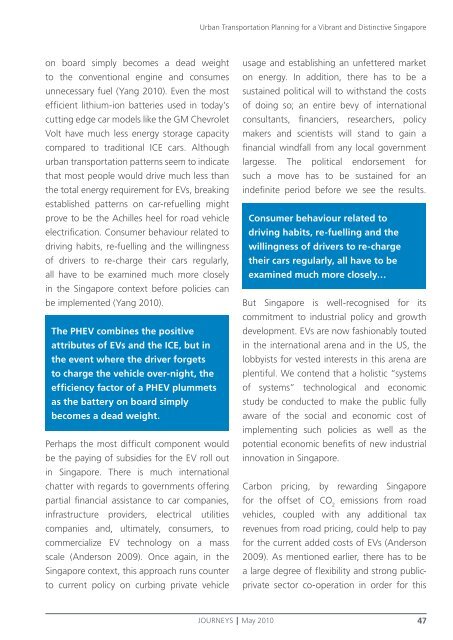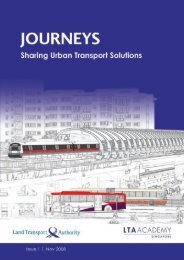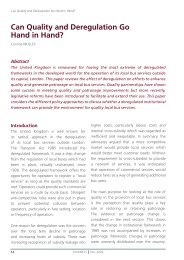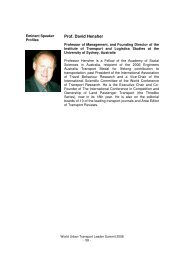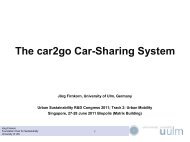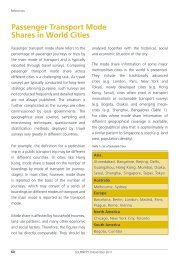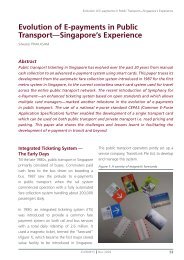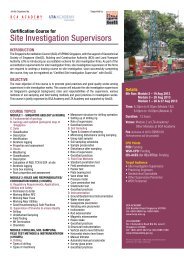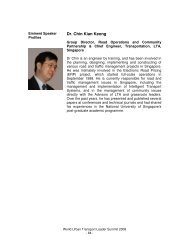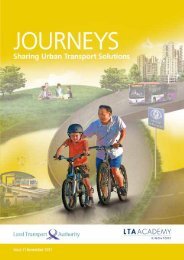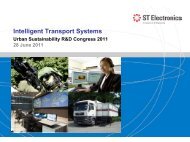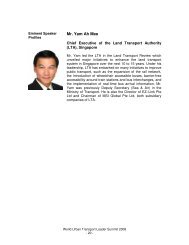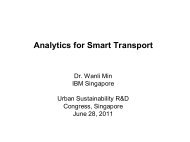Issue 4 May 2010 - LTA Academy
Issue 4 May 2010 - LTA Academy
Issue 4 May 2010 - LTA Academy
Create successful ePaper yourself
Turn your PDF publications into a flip-book with our unique Google optimized e-Paper software.
on board simply becomes a dead weight<br />
to the conventional engine and consumes<br />
unnecessary fuel (Yang <strong>2010</strong>). Even the most<br />
efficient lithium-ion batteries used in today’s<br />
cutting edge car models like the GM Chevrolet<br />
Volt have much less energy storage capacity<br />
compared to traditional ICE cars. Although<br />
urban transportation patterns seem to indicate<br />
that most people would drive much less than<br />
the total energy requirement for EVs, breaking<br />
established patterns on car-refuelling might<br />
prove to be the Achilles heel for road vehicle<br />
electrification. Consumer behaviour related to<br />
driving habits, re-fuelling and the willingness<br />
of drivers to re-charge their cars regularly,<br />
all have to be examined much more closely<br />
in the Singapore context before policies can<br />
be implemented (Yang <strong>2010</strong>).<br />
The PHEV combines the positive<br />
attributes of EVs and the ICE, but in<br />
the event where the driver forgets<br />
to charge the vehicle over-night, the<br />
efficiency factor of a PHEV plummets<br />
as the battery on board simply<br />
becomes a dead weight.<br />
Perhaps the most difficult component would<br />
be the paying of subsidies for the EV roll out<br />
in Singapore. There is much international<br />
chatter with regards to governments offering<br />
partial financial assistance to car companies,<br />
infrastructure providers, electrical utilities<br />
companies and, ultimately, consumers, to<br />
commercialize EV technology on a mass<br />
scale (Anderson 2009). Once again, in the<br />
Singapore context, this approach runs counter<br />
to current policy on curbing private vehicle<br />
Urban Transportation Planning for a Vibrant and Distinctive Singapore<br />
usage and establishing an unfettered market<br />
on energy. In addition, there has to be a<br />
sustained political will to withstand the costs<br />
of doing so; an entire bevy of international<br />
consultants, financiers, researchers, policy<br />
makers and scientists will stand to gain a<br />
financial windfall from any local government<br />
largesse. The political endorsement for<br />
such a move has to be sustained for an<br />
indefinite period before we see the results.<br />
Consumer behaviour related to<br />
driving habits, re-fuelling and the<br />
willingness of drivers to re-charge<br />
their cars regularly, all have to be<br />
examined much more closely…<br />
But Singapore is well-recognised for its<br />
commitment to industrial policy and growth<br />
development. EVs are now fashionably touted<br />
in the international arena and in the US, the<br />
lobbyists for vested interests in this arena are<br />
plentiful. We contend that a holistic “systems<br />
of systems” technological and economic<br />
study be conducted to make the public fully<br />
aware of the social and economic cost of<br />
implementing such policies as well as the<br />
potential economic benefits of new industrial<br />
innovation in Singapore.<br />
Carbon pricing, by rewarding Singapore<br />
for the offset of CO emissions from road<br />
2<br />
vehicles, coupled with any additional tax<br />
revenues from road pricing, could help to pay<br />
for the current added costs of EVs (Anderson<br />
2009). As mentioned earlier, there has to be<br />
a large degree of flexibility and strong publicprivate<br />
sector co-operation in order for this<br />
JOURNEYS <strong>May</strong> <strong>2010</strong> 47


